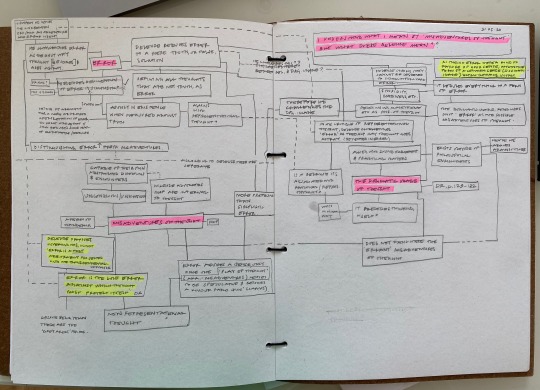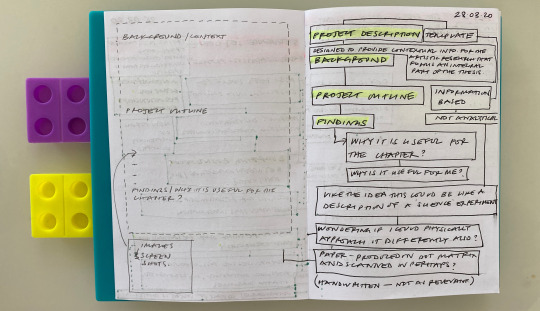Text
Opportunity I missed...
Our troubled relation to content, the interfaces of content, the machinic production of our visual realities, or the crisis of political imagination.
What does research (‘applied’, ‘artistic’, ‘pure’, etc.) do in the world? What are the challenges for research in this connection, what is productive for its development? Perhaps what is missing is a stronger account of the structures that render our research experiences, that produce new imaginaries, new spatial and temporal forms?
0 notes
Text

Arts Institute Show: Resonating Bodies
The intersect between humans and machines
Resonating Bodies explores the complexities of relationships between humans and machines. The exhibition responds to the fragility and uncertainty that we face in our increasingly digital and automated world. At a time when our sense of being is in a state of flux, the artists, Karen Abadie and Laura Rosser, lean into this unknown through the materiality of the machine. The interplay of human and nonhuman machine bodies are messy and challenged through the corporeality of the work. The machines resonate, clatter and converse in the space, through an entangling of analogue and low-fi technologies, celluloid, paper and ink. Each artist embraces the errors, slip-ups, scratches and ruptures that emerge through working with old, often broken, or malfunctioning technologies. The collective artworks pose questions around political, cultural and societal breaking down – which instead might be seen as a means to repair, renew, regenerate and refresh. The artists’ interdisciplinary practices challenge misconceptions of analogue machines as ‘obsolete’ or ‘outdated’ and reimagine human and nonhuman relationships in these precarious times.
Abadie’s practice explores what it is to be an embodied being in collaboration with the machine. The imagery presents apparently opposing embodied states that float and bounce around the exhibition space. The artwork offers a repositioning of these states with leaky messy boundaries as these materialities interweave, converse, entangle and collide. The celluloid film interacts with the heavy mass of the analogue machines, its tender surface becoming worn, scarred, scratched and even broken. The collision between human and nonhuman undeniably articulated by this apparent violence.
RESTRICTED
RESTRICTED
Rosser’s practice draws on expanded understandings of error to reimagine our
relationships with machines, systems and online spaces. Working with her collection
of dot matrix printers and printed ephemera, she creates
text-based installations
that embrace error
live as potential for unforeseen creativity, signalling a move away
from conventions of logic and order. This work creates opportunity for diverse voices and new relations to emerge.
Her playful use of language and translation
disrupt – and interrupt – rational thought and digital structures; preferring the misadventurous and crooked path.
Image:
Flesh[wound] (2022) Karen Abadie. Photograph by Beccy Strong. [mis]Feeds # 3 (2022) Laura Rosser. Photograph by Dom Moore.
#error#practice as research#post-digital#mistranslation#interuption#nonhuman#machine thinking#analogue
0 notes
Text

I am appropriating the idea of 'misadventure' from Deleuze, as a thought experiment, and thinking about errors relationship with it.
I make no claims for my interpretation of Deleuze. It helps me to understand my ideas better; as a material. Primarily my practice has allowed me to think about things in a certain way, and this is clarified by Deleuze's concept of 'misadventures of thought’ (1998).
0 notes
Photo

‘Misadventures of thought’, entangled with somewhere between the dogmatic image of thought and nonrepresentational, abstracted ideas of error?
0 notes
Photo



Trying to establish what is the function and location (if any) is for the series of diagrams I have been producing whilst writing this week.
I have been thinking about the location and function of the diagrams as part of my research, the intentions is for them to flow between thesis sections, or individual chapters. To provide a linking function. To be supportive – but not repetitive, nor representative - of the writing.
Yet, I still feel uncomfortable sharing (especially in my thesis) as they are not complete, were never designed to be so, or designed to be shared, nor to be functional beyond the point at which they were created, as a means for me to explore ideas in the moment through the diagram. They have in a sense served their purpose, which begs the question of sharing them now??
1 note
·
View note
Text
Breakdown is not a yes –– no, it is yes and no
In my research, I investigate the tensions between different interpretations of error: from the binary (and strictly digital forms) to the more abstract and human ways we approach and think about error. My interest comes from a meshing together of these tendencies and the slippages between understandings, where error is capable of breaking down and disrupting digital logic. These methods go against the ways that errors are commonly understood in digital culture, where systems try to reduce, if not erase, error or breakdown.
Error is distinct from breakdown, in that error leads to breakdown. A set of projects reveal that rational thought breaks down when error occurs, which is useful in terms of undermining digital logic, promoting a process of reconnecting, reimagining and renewal. Thus, a breakdown in logic presents an interruption to knowing and opportunity to un-learn. This expanded sense of breakdown has potential to open up new thinking; in that not knowing upholds new beginnings.
Through my practice I question how a collapse in digital logic is understood differently as a consequence of post-digital systems, practices and culture (Cramer), opening conversations about the agency of breakdown in human––machine interactions (Latour). Digital logic is commonly reductive, yet in artistic practice it is messier, and under post-digital conditions it is messier still, uncovering other creative and critical possibilities, through which we can examine social, political and technological breakdown. I create spaces which evoke a connection between the tangible and intangible, speculating on what is material, though exploring systems of knowledge, or belief, and experiences of disinformation on social media. The post-digital can nuance our understanding of error and break–ing–down, beyond a binary informational form. Provoking a discussion on how, in terms of the post-digital, a breakdown is not a yes –– no, it is yes and no (Cocker).
0 notes
Photo




Performance, Bristol
Epson dot matrix printer, MacBook, GF Smith Colourplan and Munken 120gsm
0 notes
Photo

the practice of the diagrammatic - thinking through the diagram
video still from residency at ASP, Katowice Poland
0 notes
Text

Audinio pulling tweets on errant judgements.
A human and machine dialogue
0 notes
Photo

It is hard to document the ‘printer as a disseminator of errant judgments and stereotype. With its associations with office administration and domesticity, it is an accessible object. It is capable of both machine and human thinking. Does this perspective contribute to its ability to disseminate different voices to different audiences?
0 notes
Video
tumblr
Arriving at BABE day no.1
0 notes
Photo





Few images from BABE at Arnolfini yesterday
0 notes
Text
0 notes





